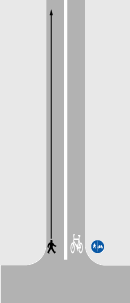
If there is a cycle lane on, or an adjacent cycleway beside, the main roadway, you must ride on it and not on any other part of the roadway.
If there is a footpath and cycleway side by side then you must ride on the cycleway. Look out for any pedestrians, particularly small children, who may step or run onto the cycleway without looking.
When riding on cycleways you must follow the rules and advice that apply to you on normal roads. Cycleways are roads - but motor vehicles are generally not permitted to enter and use cycleways.
Keep to the left of the cycle-way and allow other cyclists to pass you on the right. Overtake only on the right.
Look out for pedestrians on or crossing the cycleway, or persons working or carrying out other activities near the cycleway. They may not see or hear you coming.
Be prepared for vehicles crossing or entering the cycleway.
Ride only in the direction indicated by traffic signs and road markings. If the backs of the traffic signs are facing you , you are riding the wrong way. On a two-way cycleway keep to the left.
Be prepared to stop and give way to other cyclists at junctions with other cycleways.
End of cycleway
A traffic sign or road marking may indicate the end of a cycleway. You will usually have to join or return to the normal road and ride with other traffic. Be prepared to give way to traffic on the normal road. Look over your shoulder and wait for a safe gap in the traffic.


